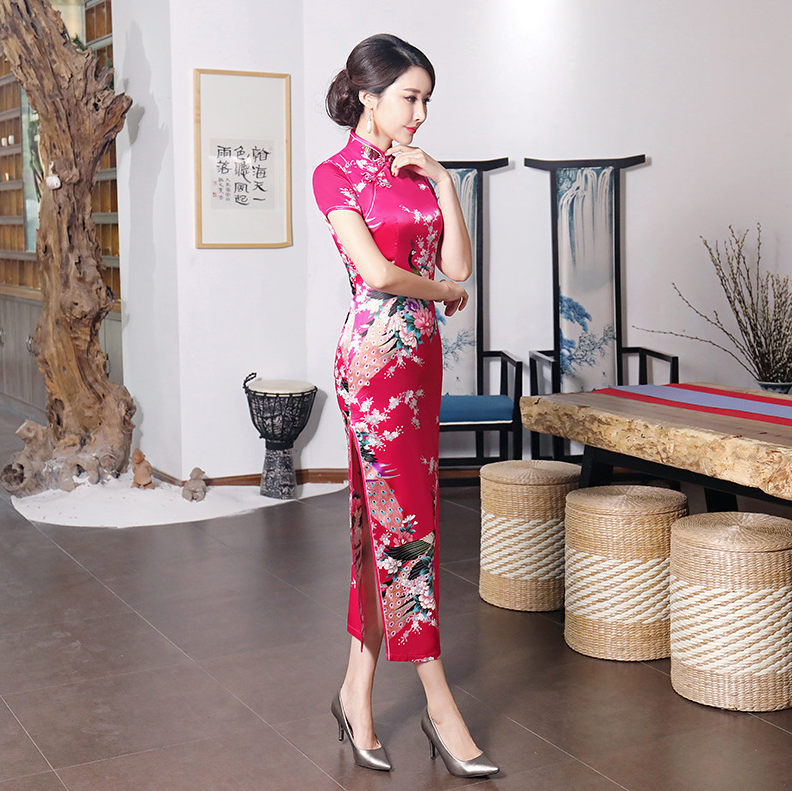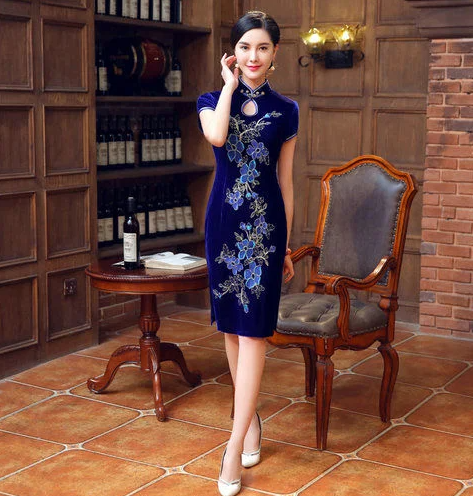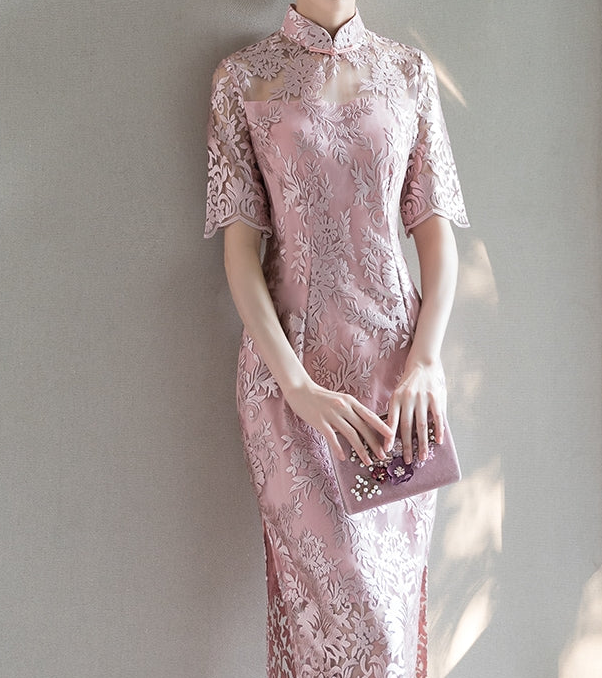The color of a Qipao reflects Chinese cultural symbolism, personal expression, and occasion appropriateness.
Introduction
The Qipao, sometimes referred to as the Cheongsam in the Cantonese dialect, is not just a dress—it’s a symbol, a piece of history, and a reflection of cultural evolution. Originating in China, its design and colors have long told stories of the time, place, and person wearing it.

Brief History of the Qipao
The Qipao’s roots trace back to the Manchu-ruled Qing Dynasty, which reigned from the 17th to the early 20th century. However, the Qipao as we know it today was heavily influenced during the 1920s and 1930s in cosmopolitan cities like Shanghai. Initially, this dress was rather loose, covering most of the woman’s body, with a focus on showing social status rather than physique.
As societal norms and fashion trends evolved, so did the Qipao. By the mid-20th century, in cities brimming with modernity like Shanghai, the dress underwent significant transformation. It became more fitted, highlighting the feminine contours, and its hemlines rose, showcasing the legs.
Here’s an in-depth look at its history on Wikipedia.
Evolution of Qipao Colors
Color has always played an integral role in Chinese culture. Each hue not only beautifies but also conveys deeper meanings and stories. For instance, during the early Qing Dynasty, Qipaos were often made in more subdued shades, reflecting the conservative values of the era.
However, with time, especially during the roaring ’20s and ’30s, as Shanghai emerged as the “Paris of the East”, a burst of vibrant colors found their way onto the Qipao. Red, symbolizing luck and prosperity in Chinese culture, became an immensely popular choice, especially for festive occasions like weddings. Blue, on the other hand, often alluded to tranquillity and elegance, making it a choice for more refined gatherings.
It wasn’t just about beauty; these colors often came with a price tag. A Qipao made from high-quality silk in a vibrant hue might cost a significant sum—reflecting both the quality of the material and the craftsmanship involved. For instance, in the 1930s, a top-tier Qipao could cost around 200 yuan, a considerable amount at the time.
Modern times have seen an array of colors, patterns, and materials being used, each bringing its unique touch and story to the dress. From luxurious gold embroidery symbolizing wealth and grandeur to the elegant simplicity of white, representing purity and innocence, the Qipao’s palette is a testament to its rich history and continuous evolution.
Significance of Colors in Chinese Culture
Colors in Chinese culture are not mere visual aesthetics; they serve as windows into the country’s history, values, and beliefs. The profundity of colors stretches back thousands of years, encompassing a wide range of emotions, symbols, and narratives that resonate deeply within the Chinese psyche.
Ancient Chinese Color Symbolism
In ancient China, colors were meticulously chosen based on their associations with natural elements, cosmology, and societal hierarchies.
- Red (红, hóng): Often dubbed the most auspicious color in Chinese culture, red is synonymous with luck, prosperity, and joy. It’s no surprise that this color dominates festive celebrations like the Lunar New Year. Historically, red was also linked to the South direction and the summer season.
- Yellow (黄, huáng): Associated with the Earth element, yellow was predominantly reserved for the emperor, symbolizing his supposed divine status and power. The legendary Yellow Emperor, who is said to have begun the Han lineage, is a testament to the color’s significance.
- Green (绿, lǜ): Representing the East, wood elements, and spring season, green connotes growth, harmony, and vitality. Ancient Chinese poets often utilized green to depict the lushness of nature in their verses.
- Black (黑, hēi): Aligned with the North, water elements, and winter, black symbolized mystery, depth, and the unknown. It also had connections to heaven and was thus often used in religious contexts.
- White (白, bái): Representing purity, innocence, and mourning, white was a color of reverence and was often associated with death. Hence, it was a common hue for funeral attires.
For more detailed insights into ancient color associations, you can dive into the Chinese color symbolism page on Wikipedia.
Cultural and Spiritual Meaning of Colors
Beyond the historical significance, colors in Chinese culture often carry deep spiritual and cultural meanings, many of which still influence modern societal norms and practices.
- Gold (金, jīn): Representing wealth, grandeur, and prosperity, gold is often seen on temples, imperial palaces, and statues of deities. The material quality and shimmering aesthetic of gold items often come at a high cost, with ancient gold artifacts being priced in the hundreds of thousands of yuan, depending on their age and intricacy.
- Blue (蓝, lán): Symbolizing immortality, healing, and tranquillity, blue is a color deeply rooted in Taoist beliefs. Taoist temples and artifacts often feature shades of blue, highlighting its spiritual importance.
- Purple (紫, zǐ): A blend of red and blue, purple signifies nobility and spirituality. Historically, only the elite could afford purple dyes, making it a marker of status.
- Brown (棕, zōng): Representing the Earth and stability, brown is often associated with groundedness and reliability.
The Color Palette of Qipao
The Qipao, with its elegant design and figure-hugging silhouette, is not merely a dress but a canvas. A canvas that paints vivid stories, emotions, and messages through its spectrum of colors. Each hue of a Qipao tells its unique tale, rooted deeply in China’s rich cultural tapestry.
Red Qipao: Symbolism and Occasions
Red, as a cornerstone of Chinese culture, stands for luck, prosperity, and joy. A red Qipao, often embroidered with intricate golden patterns, is an emblem of celebration. Brides, for instance, opt for resplendent red Qipaos for their wedding day, signaling a union filled with happiness and fortune. The cost of a high-quality red bridal Qipao can range from 1,500 to 5,000 yuan, depending on the intricacy of design and material quality.
Given its vibrant appeal, red Qipaos are also a popular choice for festive occasions like the Lunar New Year, symbolizing a fresh, prosperous start.
Learn more about the significance of the color red in Chinese culture on Wikipedia.
Blue Qipao: Representing Elegance and Calm
Blue, a hue that echoes the serenity of the skies and depth of the seas, resonates with calmness and elegance. A blue Qipao often finds its place in formal and refined gatherings. The fabric, usually silk or satin, complements the color’s sophistication, making the wearer stand out with grace.
Delving into Chinese art and poetry, blue often symbolizes tranquility and depth, reflecting a poised spirit. The price range for a handcrafted blue Qipao varies, with a mid-range one costing around 800 to 2,000 yuan.
To understand the depth of blue in art and culture, Wikipedia’s page on Chinese art can be a fascinating read.
Green Qipao: Nature and Youthfulness
Emerald, jade, and bamboo—all shades of green that resonate with nature’s vibrancy. A green Qipao, symbolic of youthfulness and vitality, is a celebration of life and growth. Often chosen by younger women, it captures the essence of spring and rejuvenation. Depending on the quality and shade of green, a decent Qipao can be purchased for 700 to 1,500 yuan.
Discover more about nature symbolism in Chinese culture on Wikipedia.
Yellow Qipao: Imperial Heritage and Joy
Yellow, once the exclusive preserve of emperors, has a rich imperial legacy. A yellow Qipao, embroidered with intricate patterns, embodies both royalty and joy. It’s a color that balances the grandeur of the past with the festivity of the present. Such Qipaos, given their imperial connection, are priced higher, typically ranging from 2,000 to 6,000 yuan.
For insights into China’s imperial history and the role of color, you can explore Wikipedia’s page on Chinese emperors.

White Qipao: Purity and Mourning
White in a Qipao is a paradox—it represents both purity and mourning. While it’s a color of innocence and simplicity, it also denotes grief and reverence for the departed. Historically, white Qipaos were worn during somber occasions, paying respect to the deceased. A well-made white Qipao can be acquired for 500 to 1,200 yuan, given its generally minimalistic design.
Modern Interpretations of Qipao Colors
The Qipao, an epitome of timeless elegance, has beautifully woven itself into the fabric of modern fashion. As the world has evolved, so has the Qipao. Its colors, once laden with traditional meanings, now shimmer with contemporary interpretations, striking a balance between the old and the new.
Contemporary Fashion and Design Influence
In the pulsating heart of cities like Shanghai and Beijing, Qipao boutiques have embraced a range of colors beyond the conventional palette. Inspired by international fashion trends, designers are experimenting with pastels, neon, and gradient hues.
- Pastel Qipaos: Inspired by global spring and summer collections, pastel-colored Qipaos exude a fresh and modern vibe. These soft shades, such as lavender, mint, and peach, bring forth a delicate charm. Depending on the fabric and design, a pastel Qipao might cost between 1,200 to 3,500 yuan.
- Neon Qipaos: Borrowing from the vibrant nightlife and street styles, neon Qipaos in shades of electric blue, hot pink, and vivid green make a bold statement. These are perfect for the modern woman looking to stand out and are typically priced around 1,500 to 4,000 yuan.
- Gradient Qipaos: Mirroring the sunset skies or the ombre trend in hair coloring, gradient Qipaos blend two colors, transitioning smoothly from one shade to another. A well-crafted gradient Qipao can be on the higher end, costing from 2,500 to 6,000 yuan.
For a deeper dive into modern fashion trends influencing traditional wear, Wikipedia’s page on contemporary fashion provides a rich context.
Merging Traditional with Modern
While new colors are flooding in, the essence of the traditional Qipao remains intact. Designers are creating fusion pieces that honor the legacy of the Qipao while incorporating modern aesthetics.
- Metallic Qipaos: Marrying the traditional symbolism of gold and silver with contemporary designs, metallic Qipaos are a blend of the past and future. Typically made with high-quality materials to achieve the shimmering effect, these Qipaos might be priced anywhere from 3,000 to 7,500 yuan.
- Dual-toned Qipaos: Taking cues from both the traditional and modern color palettes, designers are crafting Qipaos that use two contrasting colors. For example, a red and blue Qipao could symbolize both prosperity and calmness.
- Patterned Qipaos: While traditionally Qipaos showcased solid colors with perhaps a touch of embroidery, modern interpretations include floral, geometric, and abstract patterns, adding a layer of depth and modernity to the attire.
These fusions not only showcase the adaptability of the Qipao but also its relevance in today’s fashion landscape. By merging the time-honored with the trendy, the Qipao continues to be a dress that resonates across generations.
Choosing the Right Qipao Color for an Occasion
Selecting the perfect Qipao color is akin to choosing the right brush strokes for a masterpiece painting. It’s about conveying emotions, resonating with an occasion, and expressing oneself. However, with the myriad of colors available in contemporary Qipao fashion, making the right choice might seem daunting. Let’s simplify the process.

Factors to Consider: Age, Occasion, and Season
1. Age: Age plays a pivotal role in Chinese culture, often guiding the choice of attire. For younger women, vibrant colors like greens and pinks resonate with youth and vitality. Women in their middle years might gravitate towards deeper, more muted colors like navy blue or maroon, reflecting a mix of wisdom and grace. Elderly women often prefer classic colors like grey or muted blue, exuding dignity and serenity.
2. Occasion: The event dictates the dress. For celebratory occasions like weddings or Lunar New Year, red remains the quintessential choice, symbolizing joy and prosperity. For more somber events like funerals, whites and blacks are appropriate. Corporate events or formal gatherings might call for more subdued colors like blues or browns.
3. Season: Just as nature changes its hues with seasons, so does the palette of the Qipao. Spring welcomes fresh colors like greens and pastels. Summer, with its vibrancy, brings in yellows and bright blues. Autumn is all about the warmth of oranges and browns, while winter sees the elegance of whites and deep blues.
To understand the depth of age and its significance in Chinese culture, a visit to Wikipedia’s page on Chinese social structure can provide further insights.
Tips for First-time Qipao Wearers
1. Start Simple: For those unfamiliar with the Qipao, starting with a single, solid color is a safe bet. Classic colors like red or blue are versatile and suit most occasions. The cost of a basic, high-quality Qipao for beginners can range from 700 to 2,000 yuan.
2. Understand Your Palette: Everyone has a set of colors that complement their skin tone, hair, and eyes. Before venturing into vibrant patterns or contemporary hues, understand which colors enhance your natural beauty. Consulting a color chart or a fashion consultant can be beneficial.
3. Embrace Accessories: The color of the Qipao can be accentuated with the right accessories. For instance, a green Qipao can be paired with jade earrings, while a red one can be enhanced with gold jewelry.
4. Take Feedback: When trying on a Qipao for the first time, it’s helpful to take a trusted friend or family member along. They can offer feedback on the color and fit, ensuring you make the right choice.
5. Be Open to Experimentation: While it’s essential to understand traditions, don’t shy away from experimenting. The modern Qipao world is replete with colors, patterns, and designs. Find what resonates with your personality.







